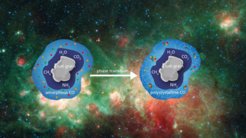
Laboratory Experiments
Origins of Life Laboratory
Dr. Jiao He (head of the lab), Dr. Tushar Suhasaria, Dr. Giulia Perotti (associated member)
We focus on the chemistry on the surface and in the bulk of ices. Ice is present in various astrophysical environments, such as on the surface of cosmic dust grains in prestellar cores and in protoplanetary disks, as well as on the surface of solar system objects. It is now well-established that complicated physical and chemical processes occur in the ice to form complex molecular species. In the Origins of Life Laboratory, we carry out laboratory experiments to simulate the processes in the ice and study the mechanisms of chemical reactions.
We have two experimental setups with different focuses.
- The first setup has two highly collimated atomic/molecular beams which can be utilized to deposit reactants on a surface. Then quadrupole mass spectrometry (QMS) and reflection absorption infrared spectroscopy (RAIRS) techniques are used to analyze the composition of the ice. We use this setup to study the formation of relatively simple molecules. We also quantify some of the fundamental surface processes that are important to surface chemistry, such as desorption, diffusion, sticking, etc.
- The second setup is currently being built. It focuses on identifying large and complex organic molecules that are produced by irradiating astrophysically relevant ice mixtures with UV light or energetic electrons. The reaction products will be desorbed by a tunable infrared laser and then ionized by a UV laser to produce ions, which then go through an ion guiding system and enter an Orbitrap mass spectrometer with very high sensitivity and mass resolution. QMS and RAIRS are also equipped to analyze simple chemicals. The focus of this setup is to identify large organic molecules that may be essential for the origins of life, such as amino acids and nucleobases.

Phase transition of interstellar CO ice and the formation of complex molecules. Interstellar dust grains are covered by an ice mantle with a layered structure. The outer layer is dominated by CO, but also contains other species such as CH3OH, HCO, CH3O, OH, H, etc. When the CO-dominated ice makes a phase transition from amorphous to polycrystalline, the minor species buried inside have a chance to segregate and react with each other. This is likely a very important mechanism by which interstellar complex organic molecules are formed. (https://iopscience.iop.org/article/10.3847/2041-8213/ac0a7c, https://www.mpg.de/17146884/co-ice )
List of group members/ associated members working on this: Dr. Jiao He, Dr. Tushar Suhasaria, Dr. Giulia Perotti (associated)
